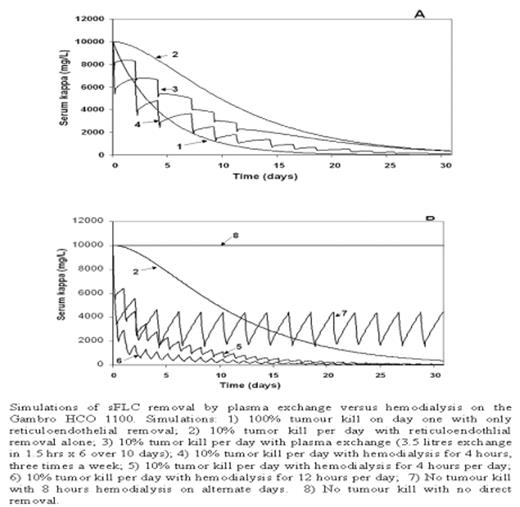Abstract
Of newly diagnosed patients with multiple myeloma, 12–20% present with acute renal failure caused by monoclonal free light chains (FLCs). Plasma exchange can reduce the pre-renal load of FLCs but randomised controlled trials have shown no clinical benefit. This disappointing outcome can be explained by the low efficiency of the procedure. A model of FLC production, distribution and metabolism in myeloma patients indicated that plasma exchange might remove only 5–10% of the total body FLCs over a three-week period. To improve removal rates we have used prolonged hemodialysis with a protein leaking dialyser. In-vitro studies indicated that the Gambro HCO 1100 dialyser, with pores of 100kDa, was the most efficient of seven tested. This dialyser was used in 10 patients with myeloma and renal failure, as part of their hemodialysis treatment, to assess FLC removal efficiency. Three of the patients were studied at initial clinical presentation with biopsy proven FLC cast nephropathy. Routine chemotherapy was used, together with prolonged daily hemodialysis and multiple measurements of FLCs in serum, urine and dialysate fluid. Serum FLCs were reduced by 40 to 70% within one hour then reduction slowed as extravascular re-equilibration occurred. FLC concentrations rebounded on successive days until chemotherapy was effective. 1.5kg of FLCs was removed from one patient over 6 weeks and another became independent of dialysis. Prolonged hemodialysis allowed removal of 5–10 times more FLCs than plasma exchange without attendant clotting problems and removal of many serum proteins (Figure 1). Proof of clinical value will require further studies.
Simulations of aFLC removal by plasma exchange versus hemodialysis on the Gambro HCO 1100. Simulations: 1) 100% tumor kill on day one with only reniculoendothetial removal; 2) 10% tumor kill per day reniculoendothetial removal alone; 3) 10% tumor kill per day with plasma exchange (3.5 liters exchange in 1.5 hrs × 6 over 10 days); 4) 10% tumor kill per day with hemodialysis for 4 hours, 3 times a week; 5) 10% tumor kill per day with hemodialysis for 4 hours per day; 6) 10% tumor kill per day with hemodialysis for 12 hours per day; 7) No tumor kill with 8 hours hemodialysis on alternate days 8) No tumor kill with no direct removal.
Simulations of aFLC removal by plasma exchange versus hemodialysis on the Gambro HCO 1100. Simulations: 1) 100% tumor kill on day one with only reniculoendothetial removal; 2) 10% tumor kill per day reniculoendothetial removal alone; 3) 10% tumor kill per day with plasma exchange (3.5 liters exchange in 1.5 hrs × 6 over 10 days); 4) 10% tumor kill per day with hemodialysis for 4 hours, 3 times a week; 5) 10% tumor kill per day with hemodialysis for 4 hours per day; 6) 10% tumor kill per day with hemodialysis for 12 hours per day; 7) No tumor kill with 8 hours hemodialysis on alternate days 8) No tumor kill with no direct removal.
Disclosures: Graham Mead & Katie Chandler are employed by The Binding Site Ltd.; Arthur Bradwell is Chairman of The Binding Site Ltd.; Hermann Goehl and Markus Storr are employed by Gambro Dialysatoren GmbH & Co KG.; Arthur Bradwell is a major shareholder of The Binding Site Ltd.
Author notes
Corresponding author


This feature is available to Subscribers Only
Sign In or Create an Account Close Modal